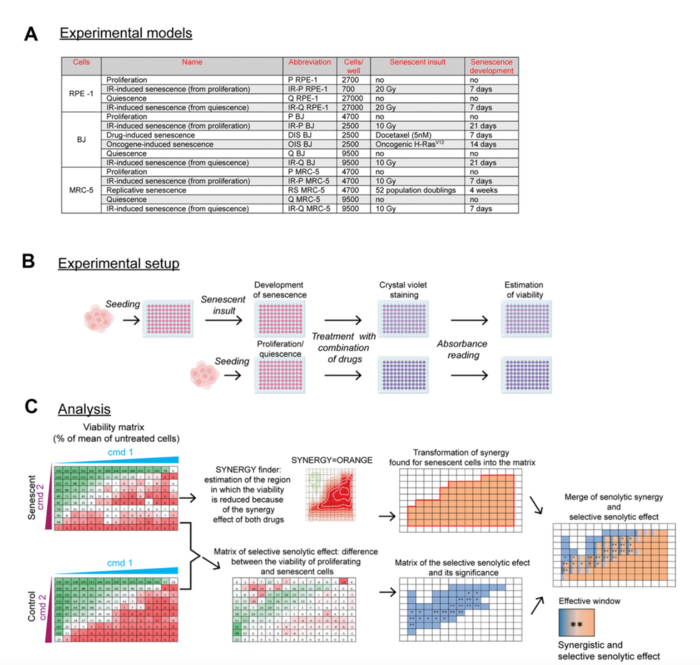BUFFALO, NY- September 1, 2022 – A new research paper was published in Aging (“Aging (Albany NY)” by Medline/PubMed, “Aging-US” by Web of Science) on the cover of Volume 14, Issue 16, entitled, “Synergism of BCL-2 family inhibitors facilitates selective elimination of senescent cells.”

Credit: 2022 Rysanek et al.
BUFFALO, NY- September 1, 2022 – A new research paper was published in Aging (“Aging (Albany NY)” by Medline/PubMed, “Aging-US” by Web of Science) on the cover of Volume 14, Issue 16, entitled, “Synergism of BCL-2 family inhibitors facilitates selective elimination of senescent cells.”
Cellular senescence, a complex cellular response to stress characterized by a halt of cell cycle progression, is one factor contributing to aging. Accumulation of senescent cells in tissues with advancing age participates in the pathogenesis of several human age-associated diseases.
Specific senescent secretome, the resistance of senescent cells to apoptotic stimuli, and lack of immune system response contribute to the accumulation of senescent cells and their adverse effects in tissues. Inhibition of antiapoptotic machinery, augmented in senescent cells, by BCL-2 protein family inhibitors represents a promising approach to eliminate senescent cells from tissues.
“In this study, with the goal of decreasing the toxicity and potential onset of resistance to senolytic BCL-2 inhibitor monotherapy, we explored the effects of combined treatment covering both BCL-2 and MCL-1 anti-apoptotic factors in human cells.”
Researchers David Rysanek, Pavla Vasicova, Jayaprakash Narayana Kolla, David Sedlak, Ladislav Andera, Jiri Bartek, and Zdenek Hodny from the Czech Academy of Sciences and the Danish Cancer Society Research Center aimed to explore synergistic and selective senolytic effects of anti-apoptotic BCL-2 family targeting compounds, particularly BH3 mimetics.
“Using human non-transformed cells RPE-1, BJ, and MRC-5 brought to ionizing radiation-, oncogene-, drug-induced and replicative senescence, we found synergy in combining MCL-1 selective inhibitors with other BH3 mimetics.”
In an attempt to uncover the mechanism of such synergy, the team revealed that the surviving subpopulation of cells resistant to individually applied ABT-737/ABT-263, MIK665, ABT-199, and S63845 BCL-2 family inhibitors showed elevated MCL-1 compared to untreated control cells indicating the presence of a subset of cells expressing high MCL-1 levels and, therefore, resistant to BCL-2 inhibitors within the original population of senescent cells.
Overall, the researchers found that combining BCL-2 inhibitors can be beneficial for eliminating senescent cells, thereby enabling use of lower, potentially less toxic, doses of drugs compared to monotherapy, thereby overcoming the resistance of the subpopulation of senescent cells to monotherapy.
“In conclusion, we propose that the selective senolytic effect of non-MCL-1 BCL-2 family inhibitors such as the known senolytics ABT-263 can be augmented by concomitant treatments with selective MCL-1 inhibitors.”
Corresponding Author: Jiri Bartek, Zdenek Hodny – Email: [email protected], [email protected]
Keywords: homoharringtonine, cellular senescence, BCL-2, MCL-1, senolytics
Sign up for free Altmetric alerts about this article: https://aging.altmetric.com/details/email_updates?id=10.18632%2Faging.204207
About Aging-US:
Launched in 2009, Aging (Aging-US) publishes papers of general interest and biological significance in all fields of aging research and age-related diseases, including cancer—and now, with a special focus on COVID-19 vulnerability as an age-dependent syndrome. Topics in Aging go beyond traditional gerontology, including, but not limited to, cellular and molecular biology, human age-related diseases, pathology in model organisms, signal transduction pathways (e.g., p53, sirtuins, and PI-3K/AKT/mTOR, among others), and approaches to modulating these signaling pathways.
Please visit our website at www.Aging-US.com and connect with us:
- SoundCloud – https://soundcloud.com/Aging-Us
- Facebook – https://www.facebook.com/AgingUS/
- Twitter – https://twitter.com/AgingJrnl
- Instagram – https://www.instagram.com/agingjrnl/
- YouTube – https://www.youtube.com/agingus
- LinkedIn – https://www.linkedin.com/company/aging/
- Reddit – https://www.reddit.com/user/AgingUS
- Pinterest – https://www.pinterest.com/AgingUS/
For media inquiries, please contact [email protected].
Aging (Aging-US) Journal Office
6666 E. Quaker Str., Suite 1B
Orchard Park, NY 14127
Phone: 1-800-922-0957, option 1
###
Journal
Aging-US
DOI
10.18632/aging.204207
Method of Research
Experimental study
Subject of Research
Cells
Article Title
Synergism of BCL-2 family inhibitors facilitates selective elimination of senescent cells
Article Publication Date
8-Aug-2022



